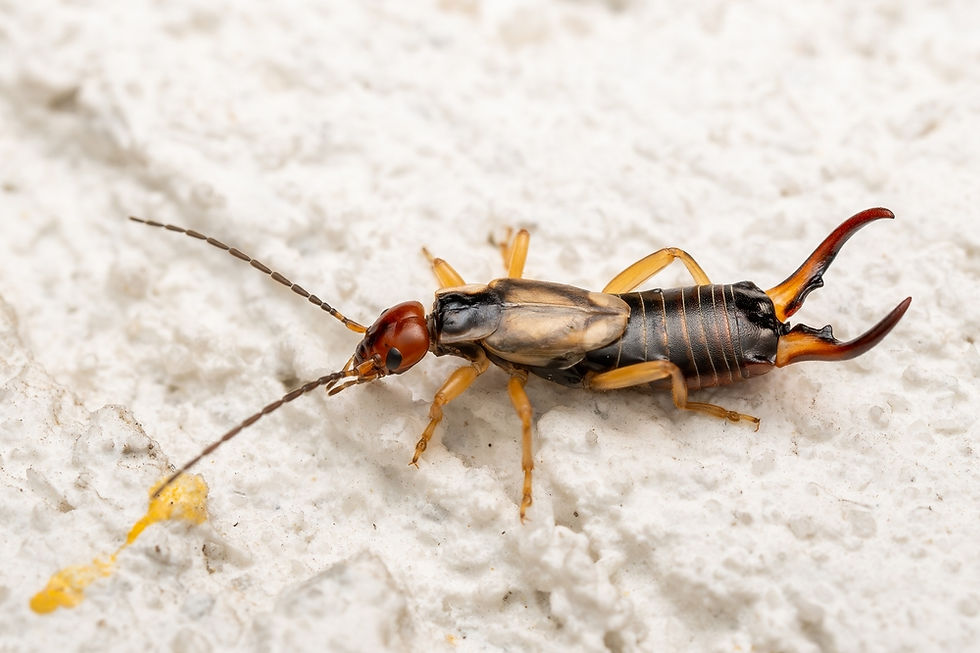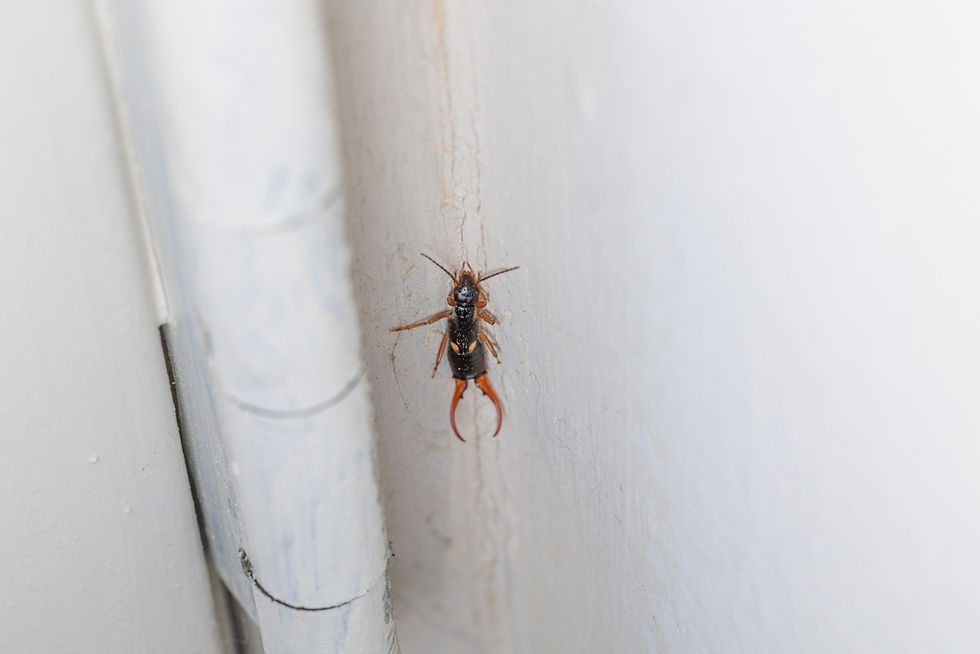Diatomaceous Earth for Earwigs
- Andy Hemmer
- Nov 17, 2024
- 6 min read
Updated: Mar 12

Earwigs or known as "pincher bugs" are common garden pests with a distinctive appearance, known for the pincer-like appendages on their rear end. While they’re generally harmless to humans, earwigs can become a nuisance if they invade your home or garden in large numbers, causing an earwig infestation that will cause damage to plants, crops, and stored food. Fortunately, diatomaceous earth (DE) is an effective and natural way to get rid of earwigs without using harsh chemicals. In this blog post, we’ll explore what diatomaceous earth is, how it works on earwigs, and the best ways to use it for successful and sustainable pest management.
What Are Earwigs and Why Control Them?
When finding earwigs, you will notice they are small, nocturnal insects that thrive in dark, damp areas in North America. They’re omnivores, feeding on both plant material and smaller insects. While they’re beneficial to some extent—feeding on pests like aphids—they can also damage garden plants, flowers, and vegetables when they become too numerous. Earwigs prefer moist environments, such as mulch beds, decaying plant matter, and wet soil, making gardens and damp basements ideal environments for them. Take a look for little black pellets (earwig excrement) as that is a sign that earwigs are around.
What is Diatomaceous Earth?

Diatomaceous earth is a fine, powdery substance made from the fossilized remains of diatoms, a type of microscopic algae with silica-based shells. When these shells accumulate over time, they form sediment that is mined and ground into DE. This powder is known for its insecticidal properties because the tiny, jagged particles can damage the outer layers of insects, leading to dehydration and death.
Types of Diatomaceous Earth:
Food-Grade DE: Safe for use around pets, humans, and plants. This type of DE is appropriate for home and garden use and is the recommended choice for earwig control.
Filter-Grade DE: Used for industrial applications and pool filtration. This type of DE contains higher levels of crystalline silica and is not safe for household pest control.
How Diatomaceous Earth Works on Earwigs

Diatomaceous earth acts as a mechanical insecticide rather than a chemical one. When an earwig comes into contact with DE, the tiny, sharp particles attach to the insect’s exoskeleton, causing microscopic abrasions. These abrasions damage the earwig’s protective outer layer, causing it to lose moisture and dehydrate, leading to its death.
Because DE works through physical contact, it’s effective against earwigs and other pests like ants, cockroaches, and slugs. Insects cannot develop resistance to DE as they might with chemical pesticides, making it a reliable long-term solution for pest control.
Benefits of Using Diatomaceous Earth for Earwig Control
Diatomaceous earth has a range of benefits for pest control, especially when it comes to managing earwigs:
Non-Toxic and Safe: Food-grade DE is safe to use around humans, pets, and the environment compared to using boric acid. It provides a natural alternative to chemical insecticides.
Long-Lasting: DE remains effective as long as it stays dry, making it a convenient option for both indoor and outdoor use.
Broad-Spectrum Control: DE can help control a variety of crawling insects, such as ants, cockroaches, fleas, and bedbugs, making it a versatile addition to your pest control toolkit.
Chemical-Free Solution: Since DE works through physical means, there’s no risk of chemical residues in your home or garden.
No Resistance Issues: Earwigs and other pests cannot build up resistance to DE, which means it remains effective over time without the need for rotation or additional treatments.
How to Use Diatomaceous Earth for Earwig Control: Step-by-Step Guide

Follow these steps to apply DE effectively and safely for earwig control in your home or garden:
1. Identify Earwig Hotspots
Look for areas where earwigs are commonly found. Indoors, this may include basements, bathrooms, or damp storage areas. In the garden, focus on mulched areas, flower beds, and around the base of plants.
2. Apply a Thin Layer of Diatomaceous Earth
Sprinkle a fine, even layer of DE around the areas where earwigs are likely to travel. For garden use, apply DE around plant bases, along garden edges, and in areas where you’ve seen earwigs. Indoors, dust it along baseboards, window sills, and other points of entry.
3. Use a Duster or Applicator for Precise Application
To avoid over-application and ensure an even spread, consider using a powder duster or applicator. A fine, even layer is more effective than thick piles, as earwigs are more likely to crawl through a thin barrier.
4. Apply DE Around Entry Points
Prevent earwigs from entering your home by applying DE around doorways, window frames, and vents. If earwigs are getting inside from the garden, sprinkle DE along the foundation of your home to create a barrier.
5. Reapply as Needed After Rain or High Humidity
Diatomaceous earth loses its effectiveness when it becomes wet, so reapply it after rain or during periods of high humidity. Indoors, DE can remain effective for weeks or months as long as it remains undisturbed and dry.
6. Combine DE with Other Preventative Measures
For the best results, use DE alongside other control methods, such as removing decaying plant matter, fixing leaks, and reducing moisture indoors. These steps can help reduce earwig populations and discourage them from returning.
Additional Tips for Using Diatomaceous Earth Against Earwigs
To make the most of diatomaceous earth for earwig control, consider these helpful tips:
Avoid Over-Application: A thin layer is typically sufficient. Thick piles of DE may deter earwigs from crossing it entirely, which reduces its effectiveness.
Drying Out Damp Areas: Since earwigs are attracted to moisture, address any excess moisture in areas where you apply DE. Use dehumidifiers indoors or improve soil drainage outdoors to create a less hospitable environment for earwigs.
Target Potential Hiding Spots: Earwigs hide in tight, dark spaces during the day, so dust DE in areas like cracks, crevices, and under stones or mulch where they might be hiding.
Use in Combination with Other Natural Control Methods: You may encourage a natural predator such as birds, spiders, beneficial nematodes, and even an earwig trap that we will explain. Combine equal parts of oil and soy sauce in a Tupperware container and bury it in the ground next to your foundation with the top of the container at the soil surface. You may use any oil (Canola, Vegetable, Olive) with the soy sauce. Earwigs will be attracted to the smell of the soy sauce, enter the container, and then become trapped because of the oil.
Frequently Asked Questions About Diatomaceous Earth and Earwig Control
1. Is Diatomaceous Earth Safe to Use Around Pets and Children?
Yes, food-grade DE is generally safe around pets and children. However, it’s best to apply it in areas where they won’t be exposed to large amounts of DE dust, as it can cause mild respiratory irritation if inhaled in high concentrations.
2. How Long Does DE Take to Kill Earwigs?
DE can start working on earwigs within a few hours, but it may take up to 48 hours for them to fully dehydrate and die. The speed depends on the level of contact and environmental conditions.
3. Can I Use DE Directly on Plants?
Yes, food-grade DE is safe for most plants. Apply it to the soil around plants rather than directly on leaves, especially on young plants, as it may dry out delicate plant parts.
4. How Often Should I Reapply DE Outdoors?
Reapplication depends on weather conditions. After heavy rain or in high-humidity conditions, DE may need to be reapplied, as moisture reduces its effectiveness.
Conclusion
Diatomaceous earth is a powerful, natural tool for controlling earwig populations both indoors and outdoors. Its non-toxic, long-lasting properties make it a great alternative to chemical insecticides, allowing you to keep your home and garden free from pests without introducing harmful chemicals. By following proper application methods, monitoring for reapplication needs, and combining DE with other preventive steps, you can create an effective and sustainable pest management solution.
For anyone seeking a safe, environmentally friendly option for dealing with earwigs and other insects, diatomaceous earth is a versatile and affordable choice that can help you maintain a pest-free environment. With consistent use, DE can help you control earwigs and protect your garden, plants, and indoor spaces naturally.






Comentarios